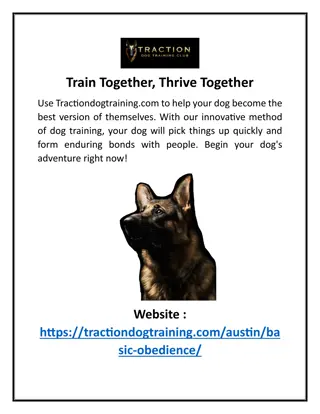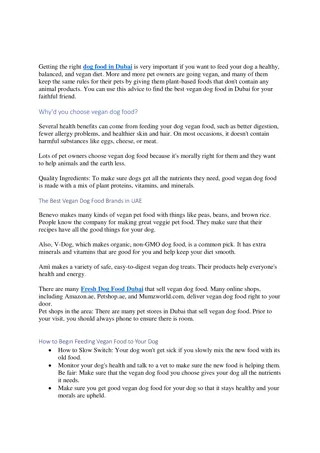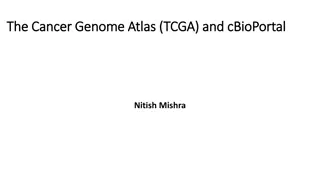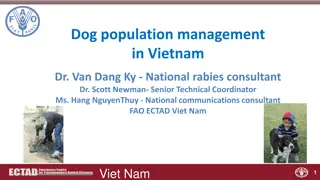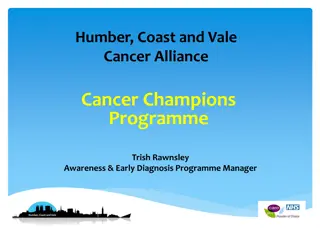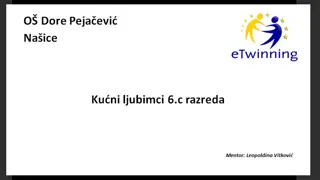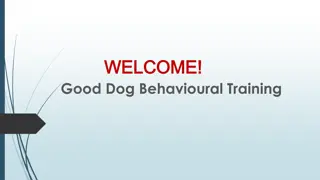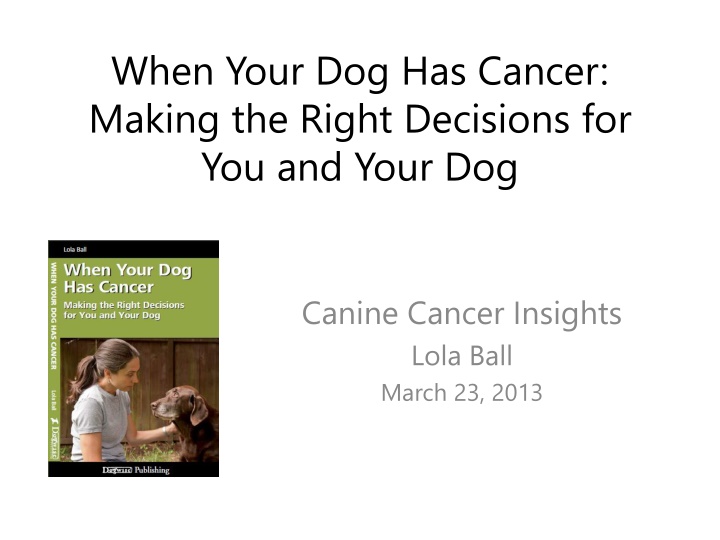
Canine Cancer: Diagnosis, Treatment, and Care Insights
Discover key insights on canine cancer diagnosis, treatment options, and caring for your dog through various stages. Learn about the importance of early detection, symptoms to watch for, diagnostic tests, and available treatment options. Make informed decisions for your beloved pet's health and well-being.
Download Presentation

Please find below an Image/Link to download the presentation.
The content on the website is provided AS IS for your information and personal use only. It may not be sold, licensed, or shared on other websites without obtaining consent from the author. If you encounter any issues during the download, it is possible that the publisher has removed the file from their server.
You are allowed to download the files provided on this website for personal or commercial use, subject to the condition that they are used lawfully. All files are the property of their respective owners.
The content on the website is provided AS IS for your information and personal use only. It may not be sold, licensed, or shared on other websites without obtaining consent from the author.
E N D
Presentation Transcript
When Your Dog Has Cancer: Making the Right Decisions for You and Your Dog Canine Cancer Insights Lola Ball March 23, 2013
Dedication He is your friend, your partner, your defender, your dog. You are his life, his love, his leader. He will be yours, faithful and true, to the last beat of his heart. You owe it to him to be worthy of such devotion. ~ Unknown Porter Jasper
Agenda The Cancer Diagnosis Treatment Options Hospice Care High Quality of Life Key Tips Natural Dying Process Q&A
The Cancer Diagnosis A diagnosis of cancer is overwhelming Importance of having a baseline for your dog What is normal for your dog? What is abnormal? Stories Jasper Kess Tango Kess, #2 Flying Disc Dog in WA State
Diagnostic Tests Blood analysis Urine analysis X-rays Ultrasound Fine needle aspirate Biopsy Surgery Increase in: Invasiveness Accuracy Risk
Catch it Early Cancer is most easily treatable if caught early Remember to have a baseline for your dog Cancer can occur anywhere And it doesn t always present itself in the way you expect Be hands-on with your dog, know their bodies Trust your instincts, get second opinions Try different laboratories for testing
Symptoms Can Appear Innocuous Wounds that would not heal and associated lameness, i.e., Kess Persistent coughing, i.e., Boomer Unusual growths or unexplained skin conditions, i.e., Nelson Sudden appearance of seizures Sudden blindness, i.e., Putter Appearance of blood in urine, i.e., Porter Vomiting and lack of appetite, i.e., Jasper Pain during normal everyday activities, like jumping or running, i.e., Alexsei Sensitivity during physical examination, for example, rectal thermometer, i.e., Lewis
Treatment Options Surgery with margins Chemotherapy side effects, non-curative Radiation therapy intense treatment, specialized facilities Immunotherapy/Genetic immunotherapy uncommon, certain cancers only Photodynamic therapy uncommon, good for prostate Antiangiogenic therapy uncommon, not every cancer Cryosurgery surface tumors Hyperthermia or thermal therapy not readily available Traditional Chinese Medicine more palliative than curative Supplemental treatments more palliative than curative Herbal supplements Homeopathy Energy medicine
Explore Research and Clinical Trials Animal Cancer Treatment Program, School of Veterinary Medicine, University of Wisconsin Madison Canine Health Foundation, American Kennel Club Morris Animal Foundation of Colorado Veterinary Teaching Hospitals A list of current clinical trials can be found here: http://cancer.landofpuregold.com/trials.htm
What Questions Should You Ask? What kind of cancer does my dog have? What is the location, stage and grade of the tumor(s)? What is the typical progression of this type of cancer and how will the progression of the disease manifest itself? What are the associated risk factors and success rates of the recommended treatment? Given your dog s health history, age and other factors, what is the likely success rate of this treatment? How much will the recommended treatment cost? What is the state of your dog s current health? What is his/her health history, including previous and current illnesses? What is your dog s experience with previous surgeries? Does your dog handle anesthesia well? How has he responded to surgery in the past?
Hospice Care Dame Cicely Saunders developed modern hospice principles in the 1950s Hospice in animals is still evolving IAAHPC Definition: Animal hospice is care for animals, focused on the patient s and family s needs; on living life as fully as possible until the time of death [with or without intervention]; and on attaining a degree of preparation for death.
Perceptions of Death Dr. Helene Starks of the University of Washington has evaluated the 1998 to 2006 statistics relating to the Death with Dignity Act in the state of Oregon In 2007, less than sixteen in 10,000 terminally ill people in Oregon chose to take lethal medication Perception != Reality
It Takes a Village An important element of hospice care is that you need to assemble your team Primary veterinarian Western Eastern Veterinary specialist Massage therapist Nutrition expert Other
High Quality of Life What is a high quality of life? Physical indicators of happiness: Tail wagging Degree of playfulness Strength of the human-canine bond Good days versus bad days Are there more good than bad? Animals live in the moment and are not caught up in the how s, where s and why s of dying
Determine Your Priorities 4 No Stress Provide pain management Ensure proper nutrition and care Provide as high a quality of life as possible in terms of physical comfort, exercise and playtime Minimize stress 3 High Quality of Life 2 High Quality Nutrition and Care 1 No Pain
Create a Hospice Toolkit Pain medications NSAIDS, Tramadol, Acetaminophen, Neurontin, etc. Alternative pain techniques Castor Oil Wrap Tellington Touch Bach Flower Essences Rescue Remedy Control nausea and vomiting Cerenia, Nux vomica, Ginger, Acupressure Control diarrhea Fast-Balance GI
Key Tips Switch to the highest quality, natural dog food that you can afford Organic fruits and vegetables Organic ground beef, turkey, and chicken; wild fish Limit grains Maximize proteins and fats cancer cells cannot process fat Provide your dog with easy, unlimited access to filtered water Ensure that your dog does not eat ANY SUGAR. Cancer cells THRIVE on sugar. It is imperative that your dog does not ingest any sugar Be flexible with your dog s tastes; have several meal options available at each meal If your dog has been on a raw food diet, some experts suggest light cooking to be more palatable and easier on digestive and immune systems. Learn how to massage your dog Think positive thoughts and create a loving atmosphere
Natural Dying Process According to Tibetan Buddhism, there are eight stages of dying. The first four stages occur during what we Westerners would consider life, and the latter four stages occur after the final exhale from the body has occurred, during what we would consider death. Stage 1 Days or weeks Decline in the animal s habits and daily functions takes place Stage 2 Days or minutes Water no longer desired; last bloom Stage 3 Minutes Shallow breathing, cease in digestion, colder body temperature Stage 4 Minutes Unaware of surroundings, infrequent breathing, twitching, howling, final fluid release, final exhale
Embrace Grief & Honor Memories Dr. Elisabeth Kubler-Ross introduced five stages of grief in her book On Death and Dying Denial Anger Bargaining Depression Acceptance Many support resources are available University of Tennessee, College of Veterinary Medicine, offers 4 free one-hour grief counseling sessions Find a way to memorialize your beloved dog
Q&A For more info, see my website at http://www.whenyourdoghascancer.org Contact me at lola@alum.mit.edu





